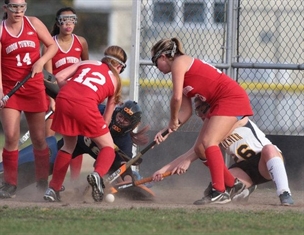
How Good is a Goal Part 2
A Guide to Judging the Best from the Rest
Thursday January 18 2018
This week we continue our guide to ‘scoring’ goals. Last week we started the discussion with an outline to goal style. The other factor when considering the merits of any goal is artistic interpretation.
The role of every Hockey players ‘inner artist’ should never be underestimated in the rating of any goal. The lowliest Seagull can be catapulted to legend status with a simple half pike with twist. Conversely a high quality team Classic can tumble down the table on the back of a peanut with his shirt pulled over his head.
Yes, His! As hard as we try to stay gender neutral here on The Reverse Stick this strange behaviour seems to effect only male players for some reason.
There has always been controversy surrounding the artistic component of any goal. What may score highly for one situation can be penalised in another. And debate has always raged over the inclusion of post-goal celebration (PGC) as an artistic element.
As an example: following a goal, the scorer runs back up the sideline, arms outstretched like a bird before being mobbed by team-mates. Pretty standard stuff. And not on its own a terrifically high scorer. But this simple act can have devastating effect on the quality of a goal.
Last minute of a World Cup Final and this sort of post goal outburst of emotional creativity would hardly affect the legacy of such a goal. Do the “Eagle Run” when you are 8-0 up and the goal will immediately incur a ‘Wally Penalty’. More on the wally penalty next week.
Of course it works the other way as well. If you are 10-0 down with seven players and you manage to score, an eagle run would be a minimum.
For the purist though, the true art is in the scoring process. It is here that the Hockey artist finds clarity. It is in this space that the true creative genius can express, through the medium of goal scoring, a unique fusion of movement and emotional content. (At least that’s what we put in the Arts Council grant submission. With any luck they will agree the goal I scored in round 7 against Lions was an expression of societies attitude to people who wear foam – Ed)
There are many seemingly obvious elements to take into consideration that all fall into four basic categories, stick, foot, body and strike. Each element relies on the others and any goal will contain all four, in differing proportions for each goal.
There are also elements that fall outside the basic four, the ‘Special Elements’. Basically anything expressed during the goal scoring process that does not contain at least two of the four basic elements. Special elements include Self Inflicted Injury, Game Situation, Players Goal Scoring Record, Dubious Umpire Intervention and several other potential acronyms.
Falling Over is a very popular special element. It is not to be confused with diving, which contains intent as a property, present in each of the four basic elements. It is closely related to Dance Fusion, which occurs most commonly when the ball is between a players feet. However is can occur spontaneously at any time. Flailing arms often add to the overall impression created by falling over. The great falling over goals often involves a player’s arse being the only point of contact with the ground.
Two basic case studies to consider. We have not included PGC here.
Player collects ball just behind half way centre field, immediately charges forward straight at the defence, beats defender one with a faint off the left, drags wide past defender two, jinks through legs of defender three, flatfoots defender four and roofs a Cracker from the top of the D. Such a goal has high percentages of all basic elements. Will rank very highly despite the lack of any special elements.
Defender attempts to clear ball from deep defence and fluffs hit, ball bobbles to attacker one who immediately smashes it toward goal without looking, ball bounces off three sticks and four feet, rolls to the lazy forward who has been standing next to the keeper for the last ten minutes. Lazy forward lunges forward to deflect ball into goal, tears hamstring in lunge. Keeper dives in direction of forward to smother ball, Ball bounces off forwards stick. Keeper misses ball, lands on forward. Ball lands on keeper’s head, bounces of helmet and into goal. While containing very low percentages of basic elements, this goal would score heavily with the presence of multiple special elements.
So now we have the backbone of a system to rank exactly how good any goal is. Next week we will find out how all this newfound knowledge can be applied in a scientific way and used with empirical measurements to quantify art.







